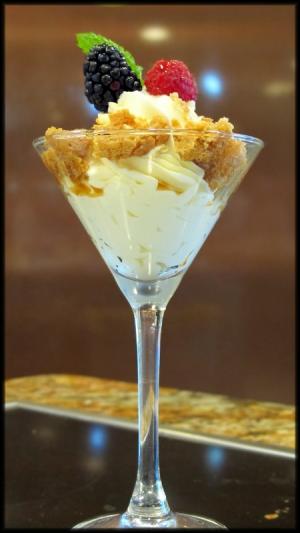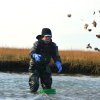Still on our cruise, while moored at port in Tortola, we spent a few hours in the Bon Appétit Culinary Center learning how to create the same dishes served in the ship’s specialty restaurant, La Toscana. From the name you can guess the focus was Italian with a spotlight on tradition. After a few fabulous meals there, we were eager to learn how to serve a reasonable facsimile once we returned home.
We began with pasta, made from scratch with eggs and OO flour. The latter ingredient sparked questions from the class about which flour was appropriate for various uses. OO flour is very soft, fine white flour with low gluten content and requires egg to hold the pasta dough together. All-purpose flour is typically a blend of soft flour with durum flour, which is very hard with very high gluten. Semolina is another hard flour that is ground coarsely and often used as part of a blended mixture to make commercial dried pasta.
After much discussion, we understood a few basics: you can make pasta without eggs if the flour is hard; you must add eggs when using soft flour. And, there’s no right answer, just taste preferences. Semolina will add a chewy texture and whole-wheat flour will add a slight graininess. The key feature to traditional pasta is fresh, all-natural eggs; their deep yellow yolks add a lovely color and rich taste to homemade noodles.
Now that we’d rolled out the pasta dough, we went on to make lasagna in the Bolognese fashion, layering the wide strips of fresh pasta with creamy béchamel and meaty tomato sauces. Unlike lasagna made from dried pasta with dollops of ricotta cheese between them, we created layers by folding the soft noodles over the filling in a single-serve baking dish. The result was nothing near the gooey versions of commercial lasagna, but a perfect marriage of flavors and textures from the elegant béchamel and lush tomato.
We also made a pasta dish using dried penne, which gave us the opportunity to properly salt the pasta water. The correct way is to add salt just as the water reaches a boil, allowing it to immediately dissolve and allowing the pasta to absorb the seasoning as it cooks. The rule of thumb is to salt the water so it will be like the sea, about one and a half tablespoons for one pound of pasta cooked in four quarts of water.
The main course on the menu was a rolled chicken breast. After placing the breast between pieces of plastic wrap, we learned the technique for pounding the meat into a uniform thickness. Instead of forcefully hammering with a meat mallet, we were shown how to pound with a forward pushing motion to spread out the flesh without disintegrating it into shreds.
Stuffing for this dish was a combination of pancetta (you could substitute prosciutto), provolone cheese and shredded sage leaves. After rolling up the chicken breast, it was draped with another slice of pancetta (you could substitute bacon) and baked. As the lean chicken breast cooked, the fat from the meat placed inside and out helped maintain moisture and add flavor. Presentation included a disk of polenta and a rich truffle sauce (see photo).
Dessert was a familiar Italian sweet, tiramisu. Here’s where we broke with tradition by inserting a shortcut into the process. The coffee-infused soaking syrup whisks together easily, but the mascarpone cream requires a little finesse. The assembly and presentation diverged from the standard practice of layering ladyfingers with a mascarpone mixture in a large serving dish and marinating overnight. Single servings quickly fill a martini glass and no overnight refrigeration is necessary - an instant pick-me-up!
With a few islands still ahead of us on the itinerary, we have a few more delicious recipes to share from our trip - next week: the elegant egg.
Rolled Stuffed Chicken Breasts
2 boneless, skinless chicken breasts
salt & pepper, to taste
8 slices pancetta
2 slices provolone
3 sage leaves, shredded
Preheat oven to 400 F. Place chicken breasts between two pieces of plastic wrap and pound into uniform 1/4-inch thickness. Remove top piece of plastic and season chicken with salt and pepper, to taste. Arrange two slices of pancetta, one slice of cheese and half the sage evenly over the chicken breast. Roll tightly, leaving behind the plastic. Place seam side down in a baking dish and drape each roll with 2 slices of pancetta. Bake for 30 minutes; remove from oven and allow to rest for 10 minutes. Slice on the diagonal and serve with polenta and truffle sauce. Yield: 2 servings.
Truffle Sauce
1/4 C Madeira
1/4 C Port
1/4 C veal demi glace
1/2 T butter
1/8 t truffle paste
Combine Madeira and Port in a small saucepan over medium heat and reduce by one-third. Stir in demi glace and continue to reduce until thickened. Swirl in butter and truffle paste. Serve warm.
Penne Michelangelo
4 oz mushrooms
3 T olive oil
1/4 C diced onion
1 minced garlic clove
3/4 lb Italian sausage
1/4 C vegetable stock
1/8 t red pepper flakes
1 bay leaf
1 rosemary sprig
2 t kosher salt
1 1/2 C penne pasta
1/4 C heavy cream
1/4 C grated Parmesan
Clean and slice mushrooms. Heat 2 T oil in a skillet and sauté mushrooms until softened. Add onion and cook until translucent. Add garlic and cook until fragrant. Remove sausage from casing and crumble into skillet. Sauté until almost cooked through, mostly browned with some pink remaining.
Deglaze the pan with the vegetable stock and add herbs. Cover and reduce heat to low; simmer for about 15 minutes. Bring a large pot of water to boil over high heat. When water starts to boil, add salt and penne. When pasta is al dente, drain and reserve 1/2 C cooking water, leaving pasta in the colander. Remove herb sprigs from the sauce, stir in cream and gently heat for a minute or two. Stir in drained pasta to the sauce in the skillet, adding some of the pasta water, if needed. Toss with half the grated Parmesan and serve, garnished with remaining Parmesan. Yield: 4 appetizer servings.
Speedy Tiramisu
1/3 C sugar
1 1/3 C espresso
1/2 C Tia Maria liqueur
1 T coffee extract
1/2 C water
1/4 C sugar
3 eggs, separated
1/2 C heavy cream
1 1/3 C mascarpone cheese
16 ladyfingers
fresh berries
mint leaves
Whisk together 1/3 C sugar, espresso, Tia Maria and coffee extract; set aside. In a small saucepan, combine water and 1/4 C sugar over medium heat. Bring to a boil, brushing down sugar crystals from the sides of the pan, until syrup registers 235 F on a candy thermometer (about 5 minutes); remove from heat. Place the egg whites in a large mixing bowl and beat until frothy and beginning to hold their shape, about 5 minutes. While running the mixer at low, pour the syrup into the egg whites. Increase the speed and continue to beat until egg whites form stiff peaks; set aside. In another mixing bowl, beat the cream until stiff peaks form, without overbeating; set aside. Combine the mascarpone and egg yolks in a large bowl and beat on high until the mixture is pale, about 4 minutes. With a rubber spatula, fold the whipped cream into the yolk mixture and then fold in the whites. To assemble: place the cream mixture into a pastry bag fitted with a medium tip. Fill the bottom of 8 martini glasses with cream. For each glass, dip one ladyfinger into the espresso syrup until damp but not sodden; crumble into glass on top of cream. Add a slender layer of cream; dip another ladyfinger into the syrup and crumble. Finish with a swirl of cream and garnish with berries and a sprig of mint. Yield: 8 servings. All recipes courtesy of Oceania Cruises Bon Appétit Culinary Center on board Marina.














.jpg)








































